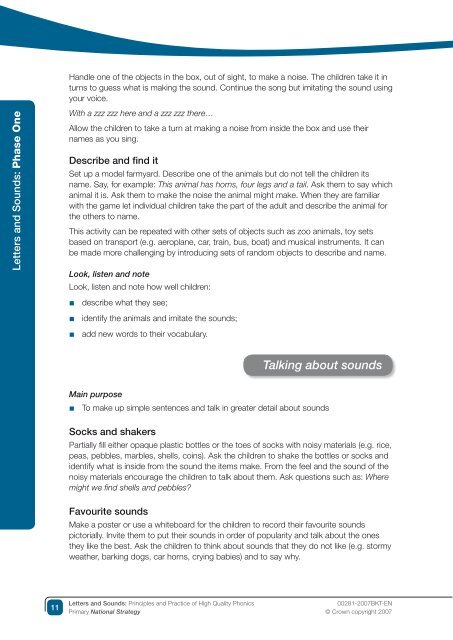Letters and Sounds 1
Letters and Sounds 1
Letters and Sounds 1
You also want an ePaper? Increase the reach of your titles
YUMPU automatically turns print PDFs into web optimized ePapers that Google loves.
<strong>Letters</strong> <strong>and</strong> <strong>Sounds</strong>: Phase One<br />
H<strong>and</strong>le one of the objects in the box, out of sight, to make a noise. The children take it in<br />
turns to guess what is making the sound. Continue the song but imitating the sound using<br />
your voice.<br />
With a zzz zzz here <strong>and</strong> a zzz zzz there…<br />
Allow the children to take a turn at making a noise from inside the box <strong>and</strong> use their<br />
names as you sing.<br />
Describe <strong>and</strong> find it<br />
Set up a model farmyard. Describe one of the animals but do not tell the children its<br />
name. Say, for example: This animal has horns, four legs <strong>and</strong> a tail. Ask them to say which<br />
animal it is. Ask them to make the noise the animal might make. When they are familiar<br />
with the game let individual children take the part of the adult <strong>and</strong> describe the animal for<br />
the others to name.<br />
This activity can be repeated with other sets of objects such as zoo animals, toy sets<br />
based on transport (e.g. aeroplane, car, train, bus, boat) <strong>and</strong> musical instruments. It can<br />
be made more challenging by introducing sets of r<strong>and</strong>om objects to describe <strong>and</strong> name.<br />
Look, listen <strong>and</strong> note<br />
Look, listen <strong>and</strong> note how well children:<br />
■ describe what they see;<br />
■ identify the animals <strong>and</strong> imitate the sounds;<br />
■ add new words to their vocabulary.<br />
<strong>Letters</strong> <strong>and</strong> <strong>Sounds</strong>: Principles <strong>and</strong> Practice of High Quality Phonics<br />
Primary National Strategy<br />
Talking about sounds<br />
Main purpose<br />
■ To make up simple sentences <strong>and</strong> talk in greater detail about sounds<br />
Socks <strong>and</strong> shakers<br />
Partially fill either opaque plastic bottles or the toes of socks with noisy materials (e.g. rice,<br />
peas, pebbles, marbles, shells, coins). Ask the children to shake the bottles or socks <strong>and</strong><br />
identify what is inside from the sound the items make. From the feel <strong>and</strong> the sound of the<br />
noisy materials encourage the children to talk about them. Ask questions such as: Where<br />
might we find shells <strong>and</strong> pebbles?<br />
Favourite sounds<br />
Make a poster or use a whiteboard for the children to record their favourite sounds<br />
pictorially. Invite them to put their sounds in order of popularity <strong>and</strong> talk about the ones<br />
they like the best. Ask the children to think about sounds that they do not like (e.g. stormy<br />
weather, barking dogs, car horns, crying babies) <strong>and</strong> to say why.<br />
00281-2007BKT-EN<br />
© Crown copyright 2007
















